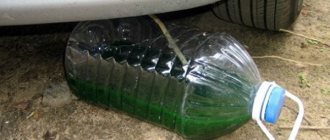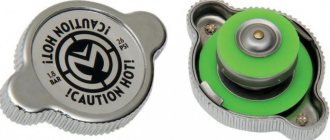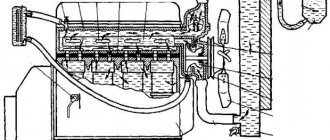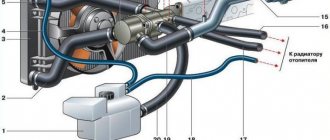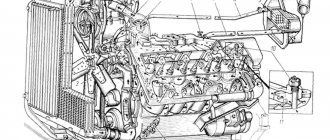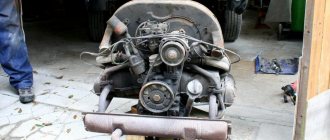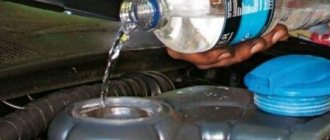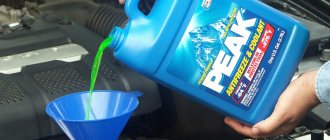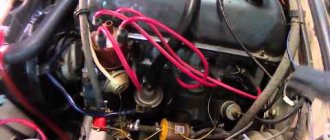If the radiator is leaking, is it dangerous?
Up to 10 - 15 liters of antifreeze are refilled into the car's cooling system. This is a small volume, so even a slight leak of coolant after a few kilometers will lead to an increase in temperature with a further warning signal coming on.
Popular brands:
Fiat Doblo, Ford C-Max, Ford Explorer
It is necessary to take measures to eliminate problems with the cooling radiator while there is still antifreeze left in the system. Otherwise, overheating leads to a significant expansion of the metal of the piston group parts, resulting in engine jamming.
Why does antifreeze leak and leak?
Antifreeze is a working fluid that circulates in the circuit of the internal combustion engine (ICE) system and is intended to cool it. A low level of coolant, loss of its properties, and the presence of air in the system can lead to the internal combustion engine not operating at the optimal temperature.
This may cause it to overheat and boil. A coolant leak is one of the most common problems and requires immediate attention. Even a small hole can eventually develop into a serious leak, which will lead to negative consequences for the car’s engine.
It is very important to find the leak immediately when the first signs of failure appear.
Possible causes of antifreeze leakage
The entire engine cooling system consists of connecting pipes and main elements. Antifreeze is a mixture of concentrate and water in certain proportions. As the engine heats up, the coolant temperature rises, causing pressure to build up in the system. Obviously, any leaks will cause antifreeze to leak. Problems can occur both with the pipes and with the main elements (pump, stove, radiator and others). In some cases, a car owner may encounter the fact that antifreeze leaks when the engine is cold.
Primary signs of a coolant leak
One of the most common primary signs that will indicate the presence of malfunctions is a constant decrease in the fluid level in the expansion tank. An exception is the natural decrease in the level of antifreeze during operation. This is not a malfunction.
For example, at negative temperatures the coolant tends to decrease in volume. After the engine warms up, the volume of antifreeze will return to normal. Also in the summer, when the system operates at its maximum level, the water in the cooler evaporates naturally.
If the liquid leaves the tank more intensively, then the cooling system needs diagnostics and repair.
Places of possible leaks
Leaks in pipes, radiator or other system elements can often be detected by wet spots. During the inspection, you should take into account the fact that cracks in the pipes can form on different sides. For this reason, all rubber connections in hard-to-reach areas should be carefully checked. If a visual inspection does not produce results, then it is necessary to check all components of the cooling system one by one. Before starting diagnostic work on the cooling system, the engine must cool down. Failure to follow this safety rule may result in injury and burns.
- Very often the culprit of the malfunction is the expansion tank or its cap. When small holes and cracks appear in the tank, the water in the antifreeze will evaporate, and larger ones will evaporate. Visually identifying such a malfunction can be quite difficult, since microcracks can be almost invisible. To eliminate a breakdown of the expansion tank, it is advisable to replace the damaged element.
- Another reason for high coolant consumption can be pipes and connections. Many car enthusiasts use a simple method to determine the location of a leak. A sheet of paper is placed under the bottom of the car and left for a certain time. The appearance of wet spots will be a signal of a malfunction.
- Another culprit for low antifreeze levels could be the thermostat. Leaking from the thermostat gasket is a fairly common problem. The housing of this unit may also be faulty. In such cases, the damaged part is replaced.
- A leak can also form inside the car. To make sure it is antifreeze, you can try it by touch. The coolant will be relatively sticky. An antifreeze leak in the cabin is most often associated with a problem in the car's heater. There are two main reasons: the connections of the pipes are depressurized or the leak occurs from the tap, which regulates the volume of fluid supplied from the engine to the stove. Breakage occurs due to mechanical wear of parts rubbing against each other.
Possible repair options
Many owners are interested in questions: how to fix leaks at the junction of the fitting and pipe, how to repair a leaking radiator, how to eliminate fluid leaks in the stove, why is antifreeze leaking?
- Pump (water pump) . In practice, there are quite often cases when antifreeze drips from the pump. Leakage occurs due to wear of the oil seal (oil seal) of the water pump. Coolant flows down the rod, after which it splashes (this will be clearly visible upon inspection). If the reason for antifreeze leaving the system lies in the water pump, then it is better to immediately replace the damaged unit, since in many modern cars the pump is driven by a timing belt mechanism. Jamming of a faulty pump can lead to a broken belt, which very often leads to bending of the valves. Repairing the engine will cost much more than replacing the pump.
- Heater radiator . Another reason for antifreeze leakage from the cooling system may be a breakdown of the heater radiator. Obvious signs of failure of this unit will be a sweetish smell of coolant in the cabin, severe fogging of the windshield, and the appearance of small puddles under the dashboard in the cabin. Repairs are carried out by analogy with the cooling radiator (replacement or soldering).
- Pipes . If the pipes rupture or cracks form in them, it is advisable to immediately replace the damaged element.
- Cylinder head (cylinder head) . The cause of a leak from the cylinder head may be a failure of the head gasket. Repair involves replacing a failed element. A more serious problem is a crack in the engine housing. Repair of this unit involves contacting specialized car services.
- Radiator . If the problem is in the radiator of the cooling system, then such an element should be replaced or repaired. Repair consists of soldering it. In some cases, you can use a special sealant for cooling systems.
How does a leak appear?
If the radiator is leaking, you need to look for the cause in the integrity of individual elements of the cooling system (engine jacket, hoses, pipes). Damage or deformation of these parts, as well as corrosion and natural wear and tear, often lead to the appearance of cracks through which leaks appear.
Antifreeze can be knocked out through the expansion tank when the engine overheats greatly.
How to check a radiator for leaks?
To find out why your car radiator is leaking, follow these steps:
- Before traveling and on the road, monitor the coolant level;
- control temperature, pressure, respond in a timely manner to the warning signal;
- regularly inspect system elements, which will allow you to detect cracks, holes or breaks in advance.
Any car radiator leak will be corrected in a timely manner if, at the first sign, you contact a service center whose technicians know what to do and how to act.
Methods for eliminating leaks
One of the reasons that your car radiator is constantly leaking may be a broken radiator cap. Due to old age, the radiator cap may not hold pressure, as a result of which the antifreeze in the system will constantly evaporate. This problem is often invisible to the eye and although the entire system is in order, the antifreeze disappears somewhere. You should replace the cap with a new one and check the antifreeze level after some time. If the level is normal, then the problem is solved.
Radiator fluid often disappears due to wear and tear on the rubber hoses. This is easy to notice by the traces of smudges on the hoses. Such pipes are recommended for replacement, since their repair is not advisable.
The most problematic option is when there is a leak in the radiator itself. Often in such cases, repairs do not help. If there is a large crack in the radiator, it is immediately noticeable by steam and coolant splashes. A large hole can only be repaired in a garage or auto repair shop. Copper or brass can be soldered, aluminum can only be welded with argon. You should know that such repairs are unreliable and even a service station will not give you a guarantee for more than a month.
This is interesting: Two simple ways to replace power steering fluid for all cars
Leak sealants
These liquid consistency products are intended for sealing small leaks on the radiator, joints of pipes, the diameter of which does not exceed 1.5-2 square meters. mm. They are poured into the expansion tank or directly inside the radiator neck.
When leaking out along with antifreeze, the sealant clogs the opening of the cooling system with a polymer film, transforming during interaction with the surrounding air.
It is important to choose sealants from good manufacturers, since low-quality compounds can clog the channels over time. After using such a product, you need to clean the cooling system using special flushes, removing any deposits from the outside.
Fillinn
Claimed, Russia, ordered and supervised by PRIDE USA
Approximate price: 60 rub.
White emulsion. It looks like it's polymer. It comes loose easily and begins to act immediately after entering the tank. I was unable to heal a 1 mm hole; I managed to heal the rest, but not quickly. The level of residual deposits is high.
+ Relatively cheap composition.
- In case of serious damage, it may not save.
GUNK Radiator Sealer Super
Declared manufacturer: USA
Approximate price: 160 rub.
The thick brown emulsion works effectively and relatively quickly; holes of different diameters closed almost simultaneously. But there were a lot of deposits left after it. On old and dirty radiators this can be dangerous.
+ Works quickly and efficiently.
— Relatively high level of residual deposits.
K-Seal
Declared manufacturer: USA
Approximate price: 430 rub.
The thick brown emulsion is declared to be “long-lasting” and does not require subsequent replacement of parts. Contains copper powder that forms durable plugs. It works quite effectively, but healing of large holes is slow. But there are very few deposits.
+ Low level of residual contamination.
— The most expensive drug in our sample.
"BBF Super"
Declared manufacturer: Russia
Approximate price: 55 rub.
The white emulsion works classically - it consistently and relatively quickly closes the holes from smaller to larger. There are very few residual deposits. After opening, neat fungi of polymer plugs are visible in the place of the holes. And at the same time - the cheapest composition among those tested!
+ The best price/quality combination. Lowest sediment level.
- Not detected.
Final table (click to open full size):
Cold welding for large holes
If the radiator is broken and large cracks and holes appear, then this problem can be solved using a plastic, homogeneous or two-component product known as “Cold Welding”. This is an indispensable emergency tool; try to always have it with you in the car.
Its complete hardening time is approximately 15 minutes. In this case, it will take about 5 minutes to completely stop the leak. As the material sets, it expands. This creates the effect of a tight cork.
Our actions:
- Before using this product, you must thoroughly clean and degrease the damaged area.
- Carefully kneaded sealing compound should be spread around the hole, gradually closing it.
This is interesting: Idle speed sensor: check, replacement, where it is located
Within an hour, the completed patch will gain the greatest strength. This is ensured by the fact that the coefficient of thermal expansion of the welding material corresponds to the metal.
Just add water
If the antifreeze leak from the cooling system is minimal, and there is nothing useful for repair in the car at all, then you can drive to a car repair shop and simply fill the leak with water:
- To prevent the engine from overheating, it is important to maintain an adequate level of coolant.
- In this case, it is better to top it up through the expansion tank.
- Water can only be added to the radiator neck when the power unit is cold.
In this case, it is recommended to use a distillate; in this case, scale formation inside the system will be minimal. But if you don’t have this luxury either, then ordinary water will also do. While driving the car, it is important to monitor the fluid level inside the radiator system.
"Folk" way
All experienced car enthusiasts know this method. It is known that ordinary powdered mustard “clogs” all small cracks. It is well diluted with water. While moving in suspension, particles of mustard powder, entering the leak cavities, accumulate, stopping it. Automotive stores sell special tablets and powders whose action is based on this principle. They often include mustard. There is no worse quality powder purchased at the nearest shopping center.
You cannot operate a car with mustard in the cooling system for a long time. It is necessary to eliminate the leak as quickly as possible using the standard method (welding, soldering). After using mustard powder, the cooling system should be flushed, as mustard can clog the narrow channels of the system.
Instead of mustard, you can use ground pepper, flour (about 10 grams) and even two raw eggs. The effectiveness of such a kitchen will be less than mustard.
How to fix a radiator leak?
During repairs, seals through which leaks occur are replaced and damage to metal parts is repaired. It is better to carry out such work at an auto center, although minor damage can be easily removed on the spot. It is recommended to make a final decision and understand how to act when a car radiator is leaking only after an inspection, since engine overheating also happens for other reasons.
The optimal methods for solving the problem are chosen taking into account the configuration of the cooling system, the characteristics of the materials from which the pipes, expansion tank, and car cooling radiator are made.
Cold welding
A cold welding mixture of metal powder is suitable for sealing damage. Components are introduced into the base for hardening and quick setting (from 1 minute to 1 hour), and then the composition is applied to the prepared surface (cleaning, degreasing).
This type of welding does not require the use of special equipment.
Sealant
Polymer sealant is used to temporarily fix the problem so that it becomes possible to get to the service center under your own power. This method allows you to seal pipes with holes or cracks up to 2 mm in size when curing to working condition in 10 minutes. If the polymer agent does not close the hole, you will have to remove the material and choose another method to restore the seal.
Soldering
Soldering allows you to repair large damage (more than 2 mm). To do this, drain the antifreeze from the system, remove the unit, clean the soldering area from contaminants, and degrease the metal. Then the damaged area is sealed, and in case of severe tears in the material, a patch of copper or brass is applied. You can repair metal elements using a gas torch by heating the solder on the damaged area.
Possible breakdowns of the cooling radiator of a VAZ 2110 car
In a liquid cooling system, the most vulnerable part is the radiator. There are several reasons for its breakdown:
- Its body is made of a thin brass sheet with a large number of soldered joints, which causes its mechanical deformation, which can even occur from a tree branch or an accidentally flying stone.
- A large number of soldered joints and resistance welding points can lead to their destruction. This is explained by a weakening of the contact zone from prolonged use in a chemical environment, a violation of the operating mode of the pump or thermostat, which increases the coolant temperature, and the valve, which can stick, is not able to relieve pressure. The result is a large number of leakage points.
Tip: You can check the tightness of the radiator by lowering it into a bath of water, after plugging the pipes. Then apply air under a pressure of 2 kgf/cm2 and hold it in the device for at least 30 seconds. During this time, no air bubbles should appear from the radiator.
Car radiator repair VAZ 2110
Device leakage is the most common cause of the problem. Coolant begins to leak from the junction of plastic and metal. Compared to replacing the radiator, the cost of repair will be significantly lower.
- The breakdown can be eliminated with your own hands; you need to purchase a special substance from a car dealership and pour it in at the same time as antifreeze. After a while the hole becomes clogged. But such repairs can be done with small holes, otherwise you will need to replace the cooling radiator on a VAZ 2110 or use another repair method.
- You can try to eliminate more complex faults by soldering and welding. For a brass radiator, soldering is used with solders made of light alloys. To do this, you need to thoroughly clean the damaged area and then you can start soldering. For patches, use a sheet of brass.
Repairing the radiator of a VAZ 2112 car by soldering
- If the surfaces of cracked tubes are damaged by no more than 10 percent, they can also be soldered. A heated rod of the required diameter is inserted into the tube. When the solder becomes soft, the tube with the rod is pulled out, and a new one is mounted in its place.
- If the issue cannot be resolved with a soldering iron, argon arc welding is used. In this case, a special aluminum welding wire will serve as a filler material. The use of argon arc welding is associated with poor weldability due to the formation of aluminum oxide deposits. In addition, the high temperature in the radiator during operation melts the elements, causes internal deformations, and reduces strength. Treating the welding site with argon protects the metal from oxidation.
- The VAZ 2110 radiator can be restored using gas-dynamic spraying. It is used in the repair of thin-walled aluminum elements. At a very high speed, a special powder is accelerated inside the radiator and a coating is formed on the damaged surface, the thickness of which is up to 1.5 millimeters.
If it is impossible to perform one of the listed operations, you will need to replace the VAZ 2110 cooling radiator.
